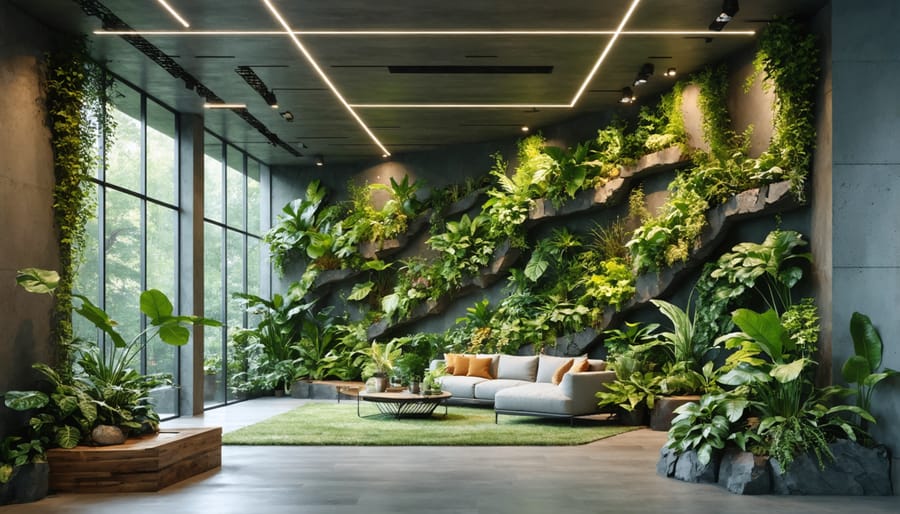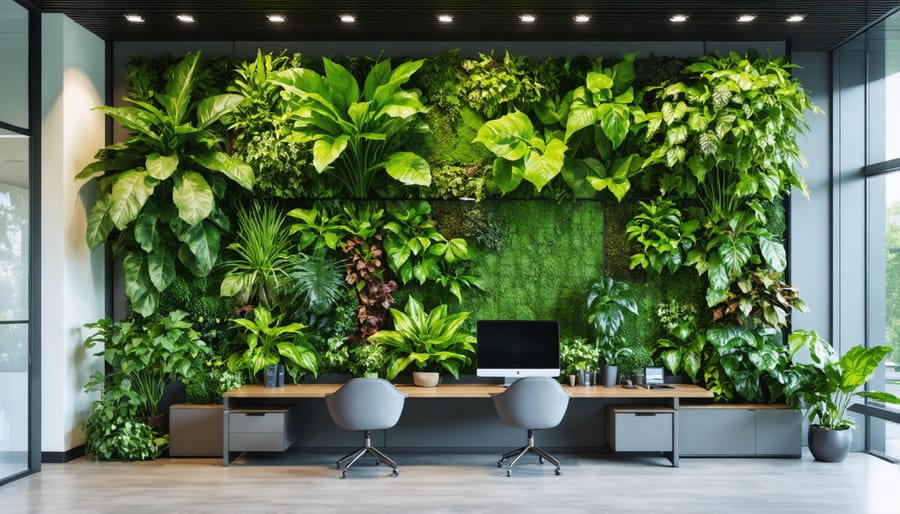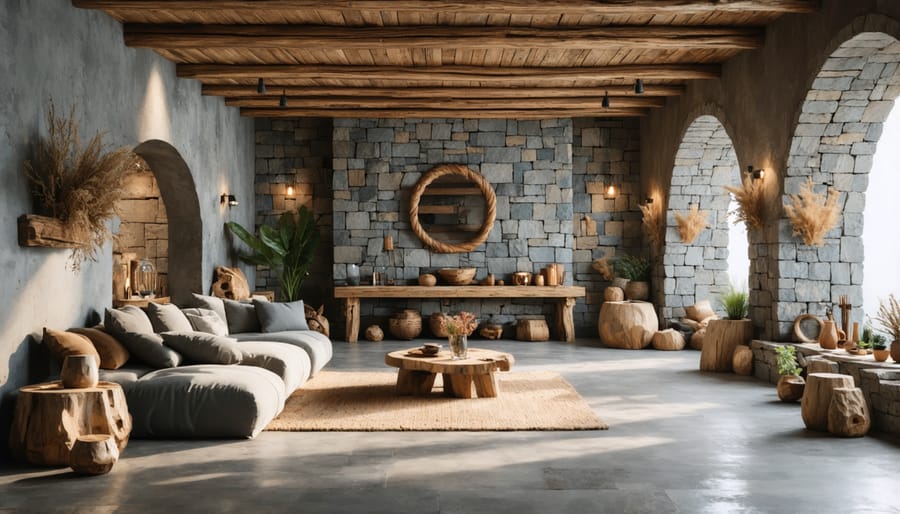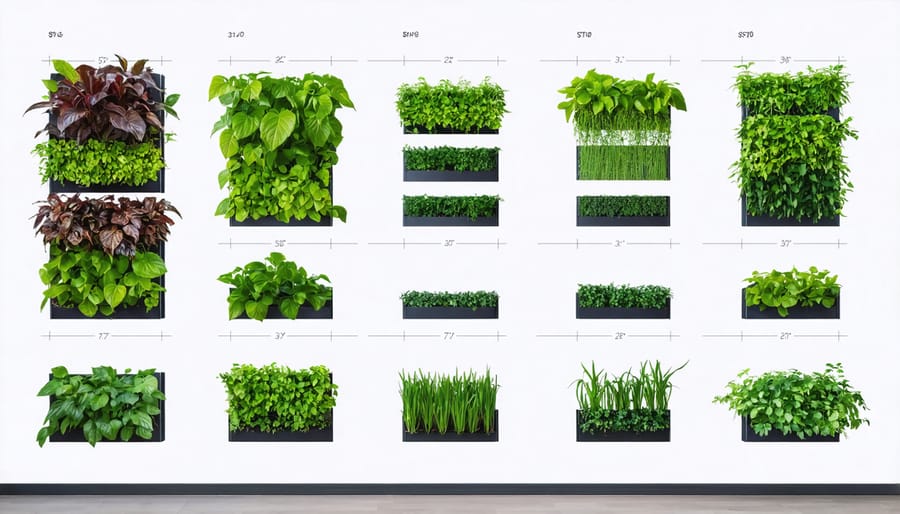
Transform Your Space: Biophilic Design That Brings Nature Indoors
Transform your living space into a natural sanctuary with biophilic interior design ideas that seamlessly blend the outdoors with your indoor environment. This nature-inspired design approach doesn’t just create stunning spaces—it’s scientifically proven to reduce stress, boost creativity, and improve overall wellbeing. By incorporating living walls, natural materials, and abundant daylight, biophilic design bridges the gap between our modern lives and our innate connection to nature. Whether you’re redesigning a home office, revamping a living room, or planning a commercial space, these design principles offer practical solutions that deliver both aesthetic beauty and measurable benefits to occupants. From simple DIY projects like creating indoor gardens to sophisticated architectural elements that maximize natural light, biophilic design transforms ordinary spaces into extraordinary environments that nurture both body and mind.
The Science Behind Biophilic Interior Design
Health Benefits
Research consistently shows that incorporating natural elements into interior spaces can significantly improve your wellbeing in multiple ways. Studies have found that biophilic design elements reduce stress levels by up to 60% and decrease blood pressure. Exposure to natural light and green spaces has been linked to better sleep quality and increased productivity, with some workplaces reporting a 15% boost in employee efficiency.
The presence of indoor plants and natural materials has been shown to enhance air quality by reducing toxins and increasing humidity levels. This can lead to fewer respiratory issues and decreased symptoms of allergies. Additionally, spaces with biophilic design elements promote better mental health, with occupants reporting reduced anxiety and improved mood.
Views of nature and natural patterns have also been connected to enhanced creativity and faster recovery times in healthcare settings. Even simple additions like wooden furniture or nature-inspired artwork can trigger these positive physiological and psychological responses, making biophilic design a powerful tool for creating healthier indoor environments.
Stress Reduction Elements
Biophilic design elements have been scientifically proven to reduce stress levels and enhance overall well-being in indoor spaces. Natural lighting through large windows or skylights triggers the release of serotonin, improving mood and regulating sleep patterns. The presence of indoor plants has been shown to lower blood pressure and reduce anxiety, with studies indicating even a single plant can make a significant difference.
Water features, such as small fountains or wall-mounted waterfall displays, create calming white noise that masks disruptive sounds and promotes relaxation. The gentle sound of flowing water has been linked to decreased cortisol levels and improved concentration. Natural materials like wood and stone provide textural variety that engages our senses positively, while earth-toned color schemes mirror nature’s palette to create a sense of stability and groundedness.
Living walls and vertical gardens not only purify the air but also provide a direct connection to nature that reduces mental fatigue. Even simple elements like nature-inspired patterns in textiles or wallpaper can trigger positive psychological responses, making spaces feel more welcoming and peaceful.
Essential Elements of Biophilic Design
Natural Light and Views
Natural light is a cornerstone of biophilic design, serving as a direct connection to the outdoor environment and promoting well-being. Large windows, skylights, and glass doors not only flood spaces with daylight but also create visual links to nature that can reduce stress and improve mood.
To maximize natural light, consider removing heavy window treatments or replacing them with sheer fabrics that filter light while maintaining privacy. Strategic mirror placement can help bounce light deeper into rooms, while light-colored walls and reflective surfaces amplify the brightness throughout your space.
When designing your layout, position frequently used areas like workstations and seating near windows. Create unobstructed sight lines to outdoor spaces, incorporating views of gardens, trees, or even urban greenery. For spaces with limited window access, consider installing interior windows or glass partitions to share natural light between rooms.
Don’t forget about transitional spaces like patios and balconies – these areas can blur the lines between indoor and outdoor living, enhancing the biophilic experience. Even small changes like keeping windows clean and trimming outdoor vegetation that blocks light can significantly impact your connection to nature.
Living Elements
Plants and water features are the beating heart of biophilic design, bringing immediate life and energy to any space. Start with low-maintenance indoor plants like snake plants, pothos, or ZZ plants in areas with indirect light. Create vertical gardens using wall-mounted planters or hanging baskets to maximize space while adding visual interest. For larger areas, consider statement pieces like fiddle leaf figs or bird of paradise plants.
Water features add both visual appeal and soothing white noise to your environment. Desktop fountains work well in home offices, while wall-mounted water features can serve as stunning focal points in living areas. For a more subtle approach, try tabletop fountains or small bubble walls that don’t require extensive installation.
Remember to group plants according to their care needs – keeping high-humidity lovers together makes maintenance easier. For busy spaces, consider self-watering planters or smart irrigation systems. In commercial settings, preserved moss walls offer a maintenance-free alternative while still providing the psychological benefits of connecting with nature.
Choose containers that complement your existing décor, and don’t forget to include proper drainage to protect your floors and furniture.

Natural Materials and Textures
Natural materials and textures form the foundation of biophilic design, creating an authentic connection to the outdoors. Wood stands out as one of the most versatile materials, bringing warmth and character through exposed beams, hardwood flooring, or accent walls. Consider incorporating reclaimed wood for added sustainability and unique character.
Stone elements, whether through granite countertops, slate flooring, or river rock features, add an earthy, grounding presence to any space. These materials not only look beautiful but also provide tactile experiences that enhance our connection to nature.
Other organic materials worth exploring include bamboo, cork, and rattan. These sustainable options offer varying textures and patterns that can be incorporated through furniture, wall coverings, or decorative elements. Natural fibers like jute, wool, and cotton work beautifully in textiles, adding layers of organic texture through rugs, curtains, and upholstery.
When selecting materials, prioritize those with minimal processing to maintain their natural characteristics. Mix different textures and materials to create visual interest while maintaining a cohesive, nature-inspired aesthetic. Remember that even small additions, like a stone vase or wooden bowl, can make a significant impact.

Natural Patterns and Forms
Natural patterns and forms are at the heart of biophilic design, bringing the organic beauty of nature indoors. Think of the spiral patterns in seashells, the veining in leaves, or the hexagonal shapes of honeycomb – these natural geometries can be incorporated through wallpaper, textiles, and decorative elements. Try adding curved furniture pieces that mimic flowing water or rolling hills, rather than strict geometric shapes. Area rugs with botanical patterns, throw pillows featuring leaf prints, or wall art depicting natural fractals can instantly add biomorphic elements to your space.
Consider incorporating materials with natural patterns, such as wood with visible grain patterns, stone with distinctive veining, or textiles with organic motifs. Even lighting fixtures can reflect these natural forms – look for pendant lights that mimic dewdrops or chandeliers that echo the branching patterns of trees. For a subtle approach, choose cabinet hardware with nature-inspired shapes or install tiles that feature gentle, wavelike patterns.
Remember, these patterns shouldn’t feel forced or overwhelming. The key is to create a subtle connection to nature that feels both sophisticated and calming.
DIY Biophilic Design Projects
Living Wall Installation
Ready to transform your walls into a lush, vertical garden? Creating a living wall is easier than you might think. Here’s your step-by-step guide to installing a stunning botanical feature in your space.
Start by selecting an appropriate wall that receives adequate indirect light. Install a moisture-resistant backing board to protect your wall from water damage. Next, attach a frame system with built-in irrigation channels – you can find pre-made options at most garden centers.
Choose your plants carefully. Mix different textures and colors, but stick to species that have similar care requirements. Popular choices include pothos, ferns, peace lilies, and air plants. Consider incorporating moss for fuller coverage between larger plants.
Install the irrigation system, ensuring even water distribution. Most modern systems include programmable timers and moisture sensors. Layer your growing medium – typically a combination of coconut coir and hydroponic substrate – into the frame’s planting pockets.
Begin planting from bottom to top, securing each plant firmly. Space them according to their growth patterns, allowing room for expansion. Add a water collection tray at the base to catch excess runoff.
Maintain your living wall by monitoring moisture levels, trimming as needed, and checking the irrigation system monthly. With proper care, your vertical garden will flourish, creating a stunning natural focal point while improving air quality and acoustic comfort in your space.

Natural Light Enhancement
Natural light plays a crucial role in biophilic design, creating spaces that feel more connected to the outdoor environment while promoting well-being and energy efficiency. To enhance natural lighting in your space, start by evaluating your window treatments. Opt for sheer or light-filtering curtains that allow sunlight to penetrate while maintaining privacy. Consider installing mirrors strategically across from windows to reflect and amplify natural light throughout the room.
Color choices significantly impact light distribution. Select light, reflective paint colors for walls and ceilings, particularly in rooms with limited natural light. Glossy or semi-glossy finishes can help bounce light around the space more effectively. Position furniture to avoid blocking windows and consider glass or translucent pieces that won’t obstruct light flow.
For spaces with architectural limitations, consider installing skylights or solar tubes to bring natural light into darker areas. Glass doors or interior windows can help light travel between rooms. Keep windows clean and unobstructed by trimming any outdoor vegetation that might block sunlight.
Smart design elements like light shelves can direct sunlight deeper into rooms while reducing glare. Use reflective surfaces like metallic accents or glass tiles to create subtle light-catching points throughout the space. Remember to balance natural light with proper window treatments to manage heat gain and maintain comfort throughout the day.
Natural Material Integration
Natural materials serve as the foundation of biophilic design, bringing the outdoors inside through thoughtful material selection. Start by incorporating wood elements, which add warmth and texture to your space. Consider reclaimed wooden beams for ceiling features, hardwood flooring, or wooden furniture pieces with visible grain patterns. Bamboo offers a sustainable alternative that brings similar natural appeal while being highly renewable.
Stone and slate elements add an earthy, grounding presence to your interior. Use these materials for accent walls, fireplace surrounds, or countertops. Natural stone tiles in bathrooms or kitchens create a spa-like atmosphere while maintaining durability. For smaller touches, consider incorporating river rocks in decorative bowls or as part of bathroom design elements.
Natural fibers like jute, sisal, and cotton bring organic texture to your space through rugs, curtains, and upholstery. These materials not only look authentic but also feel pleasant to touch, enhancing the sensory experience of your environment. Cork is another versatile material that works well for both decorative elements and functional pieces like wall panels or furniture.
For accent pieces, consider incorporating woven baskets, clay pottery, or shell decorations. These elements add visual interest while maintaining the natural theme. When selecting materials, opt for those with minimal processing to preserve their authentic appearance and tactile qualities. Remember that natural materials often develop a beautiful patina over time, adding character to your space as they age.
Maintenance and Care
Maintaining a biophilic interior requires regular attention to keep natural elements thriving and looking their best. For living plants, establish a consistent watering schedule and check soil moisture weekly. Different plants have varying needs, so group those with similar water requirements together for easier maintenance. Use a moisture meter for precise monitoring, especially for larger indoor plants.
Natural light management is crucial for both plants and materials. Rotate potted plants quarterly to ensure even growth, and regularly dust leaves to maximize photosynthesis. For wooden elements, apply appropriate sealants annually to prevent warping and maintain their natural beauty. Consider using protective UV films on windows to prevent fading of natural fabrics and materials.
Living walls require special attention. Install an automatic irrigation system if possible, and check it monthly for proper function. Trim dead leaves and replace any failing plants promptly to maintain the wall’s aesthetic appeal. For water features, clean filters bi-weekly and check water quality regularly to prevent algae growth.
Natural textiles and materials should be cleaned according to their specific requirements. Vacuum natural fiber rugs weekly and have them professionally cleaned annually. For stone surfaces, use pH-neutral cleaners to preserve their natural appearance. Regular maintenance not only extends the life of biophilic elements but also ensures they continue to provide maximum psychological and environmental benefits to the space.
Bringing nature indoors through biophilic design isn’t just a trend – it’s a powerful way to transform your living spaces into vibrant, nurturing environments. Whether you start small with a few strategically placed plants and natural materials, or dive into a complete space transformation with living walls and natural light optimization, every step toward biophilic design enhances your connection with nature. Remember that successful implementation doesn’t require a complete overhaul; you can begin with simple changes and gradually build upon them. By incorporating natural elements, maximizing daylight, choosing organic materials, and maintaining indoor plants, you’re not just decorating – you’re creating a healthier, more productive, and more enjoyable environment. Take the first step today in your biophilic design journey, and watch as your space transforms into a natural sanctuary that promotes wellbeing and harmony.
